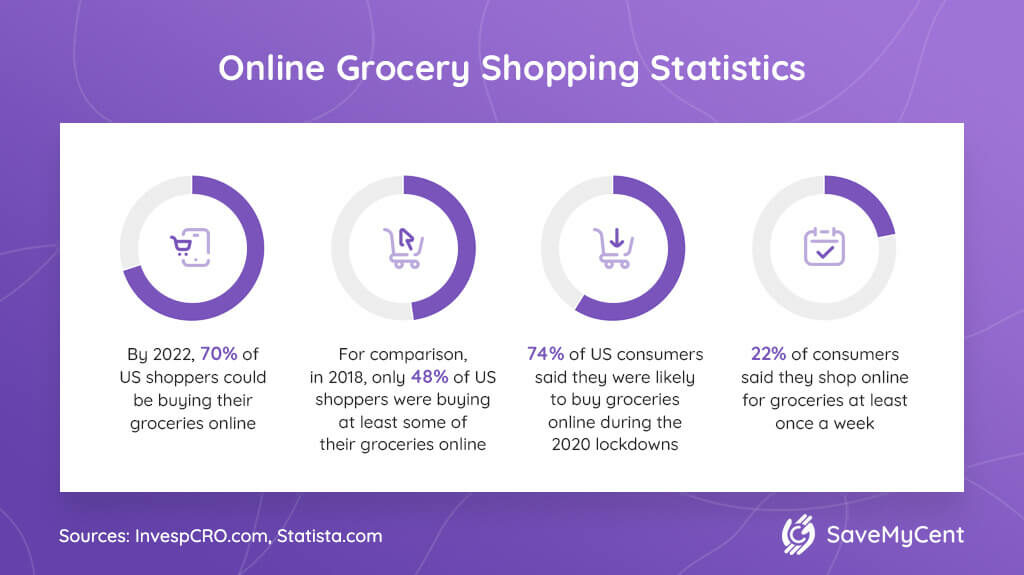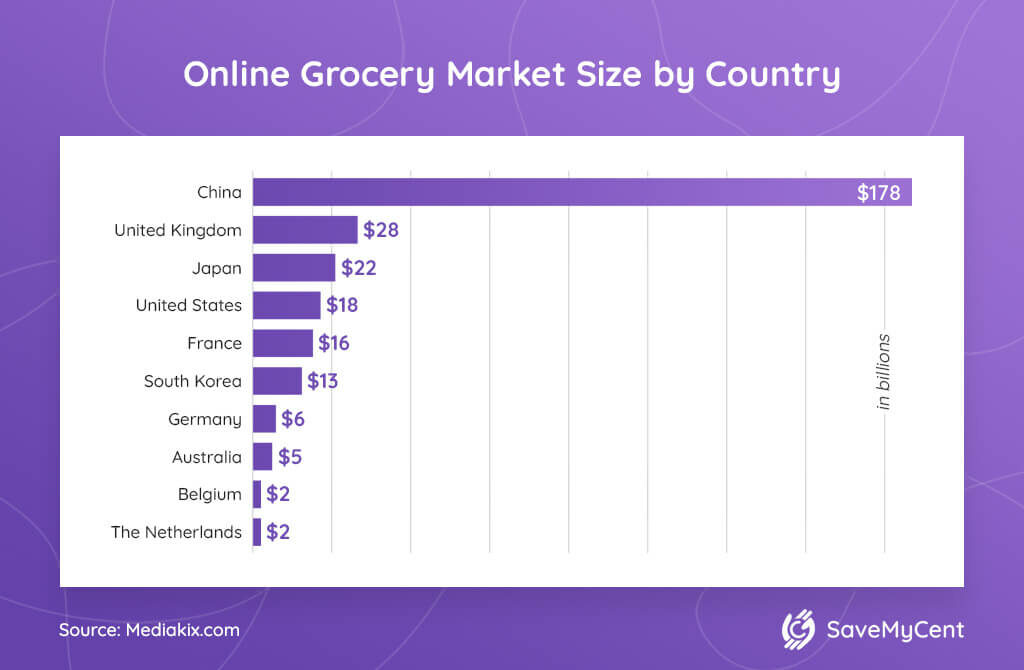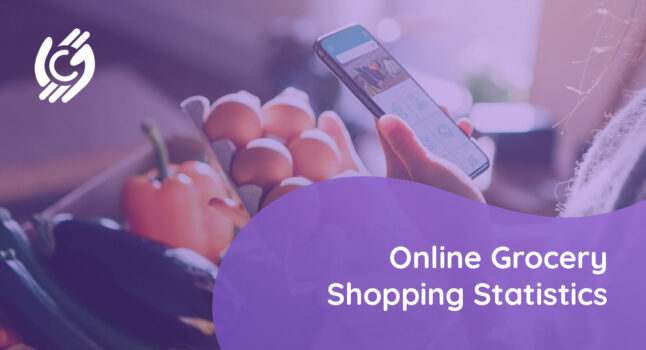Before the days of the internet, we had to visit our local supermarkets to buy our groceries. Things have changed quite a bit since then.
Thanks to our busier lifestyles, more and more people are buying their weekly groceries online, and this has been demonstrated clearly by the online grocery shopping statistics we have explored. Considering the price for delivery to your home, this is no surprise.
So, how popular is online grocery shopping today? After trawling through all of the grocery shopping online statistics we could find, the answer seems clear. Here are some interesting facts about the online grocery market to kick things off.
Fascinating Grocery Shopping Facts (Editor’s Choice)
- 70% of US shoppers will be buying groceries online by 2022.
- Walmart was the most popular online grocery store in the US for 37% of American residents.
- By 2029, ecommerce warehouses could be fully automated.
- Using in-store events, classes, or pop-ups can increase sales as much as 40%.
- Grocery market share in the United States will experience an increase of $35.6 billion by 2023.
- By 2024 the global grocery retail market will have grown by 24%.
Online Grocery Shopping Trends
Traditionally, most Americans did their grocery shopping in supermarkets, but this situation is changing as more and more people switch to online shopping. Urban, young and affluent households seem to be embracing this trend most vigorously.
1. By 2022, 70% of shoppers in the US could be buying their groceries online.

In 2018, only 48% of grocery shoppers in the US were buying at least some of their groceries online. Going forward to 2022, this number could rise to 70%, representing an increase of 22%, according to the latest grocery shopping statistics.
2. In 2020, 74% of Americans said they would purchase groceries online during lockdown.
(Statista, Digital Commerce 360)
What ensued was a complete explosion of online grocery shopping. In fact, the growth of online grocery delivery for some products was previously unseen. For example, online grocery trends for 2020 show that the sales’ of wineries that sell directly to wine lovers grew from 2% pre-pandemic to around 10% of an average winery’s total sales.
3. Merchants that link with logistics companies and trucking fleets can reduce their fleet costs by about 30%.
(LS Retail)
One of the recent grocery shopping trends is the linking up of logistics companies and trucking fleets via mobile apps. This is expected to share capacity between the various entities, which could reduce overall fleet costs by as much as 30%.
4. Young, affluent and urban households buy online groceries more than other demographics.
(eMarketer)
Online grocery demographics show that affluent, urban, or young households are the most likely to buy groceries online. Not surprisingly, these groups are also time conscious and crave value convenience.
Online Grocery Industry
Amazon was the most popular grocery store in the USA this year, according to online grocery shopping statistics. Target also proved to be popular, particularly for in-store purchases. The popularity of buying groceries online is definitely on the up. $189.81 million will be spent this year in total, while food and drink sales in the US will grow by 18.2%.
5. In 2020, shoppers were most satisfied with their online grocery shopping experience at Amazon with a score of 4.63.
(The Retail Feedback Group)
According to the RFG report from December 2020, the second most popular online grocery store in the USA was Walmart with a score of 4.41. However, both online retailers were highly successful in 2020, as both managed to increase customer satisfaction within months.
6. Only 14% of people bought online at Target in 2020.
(TABS Analytics)
Online grocery market share by company tells us that only 14% of Target’s customers buy goods online (compared to 15.7% in 2019). This is a far cry from Walmart, currently number one in this spot for online grocery shopping in 2020 at 30% penetration. Also, traditional supermarkets saw significant growth in market penetration from 10% in 2019 to 14% in 2020.
7. $89.2 billion was the estimated spend on online groceries in 2020.
(eMarketer)
This figure, based on online grocery shopping trends in 2020, is impressive. And it doesn’t appear it will fall anytime soon. According to estimates, in 2021, online grocery sales in the US will reach $93.83 billion.
8. Food and beverage sales increased by 18.9% in the US during 2020.
(eMarketer)
In other words, sales reached $23.65 billion by the end of 2020. In 2021, this figure will grow even further, according to online grocery sales statistics. Sales will reach $38.16 billion. This is still only 2.7% of total food and beverage sales.
Statistics for Online Grocery Shopping
Ecommerce sales appear to be promising. Walmart alone saw a 74% improvement in its ecommerce sales at the end of 2020. As a whole, digital grocery sales could experience impressive growth by 2023 of up to 151%. And by 2029, ecommerce warehouses could be fully automated.
9. By 2029, ecommerce warehouses could be fully automated.
(Whisk)
Grocery ecommerce trends suggest that in ten years, ecommerce warehouses could be fully automated. This will allow companies to deliver cheaper and more quickly, which is what customers demand. Ocado has already created a semi-automated warehouse, but humans still need to be present to make it work.
10. By 2023 US digital grocery sales will increase 149%.
(Invesp)
In 2018, total digital grocery sales in the US reached 23.9 billion, and it’s expected to grow to $59.5 billion by 2023, according to US online grocery shopping statistics. This is a 149% increase in digital grocery sales in the US, which is impressive growth for only a five-year period.
11. Walmart’s US ecommerce sales grew by 79% in Q3 2020.
(Walmart)
At the end of 2020, Walmart experienced growth in its total revenue of 6.4%, and ecommerce grocery sales played a large part in this. Walmart online grocery shopping statistics have indicated that its online grocery sales improved by 79% in the same period.
Grocery Stores Statistics
Grocery stores experienced consistent growth between 2015 and 2020, buoyed by the strong economy, but curbed by inflation and strong competition from things like online grocery sales. There are still lots of things retailers can do to improve their sales, like build micro fulfillment warehouses on their premises. Despite a lack of growth, conventional supermarkets remain the most profitable category in the US, or so the online grocery shopping statistics tell us.
12. Grocery store market size has increased by 1.2% per year between 2015 and 2020.
(IBISWorld)
Grocery store statistics tell us that between 2015 and 2020, the market size has increased by 1.2% year on year. High competition is the primary negative factor affecting industry growth: specifically, the competition faced with online groceries. Another negative factor is inflationary food cost, which forces a shift towards more generic goods.
13. Using in-store events, classes or pop-ups can increase sales as much as 40%.
(LS Retail)
A Wall Street Journal report recently indicated that the retailer ‘Origins’ was able to improve their sales between 20% and 40% just by investing in techniques to encourage customers to linger in the store. However, grocery store trends tell us that this isn’t the only method for improving sales. Special events and pop-up experiences also boost engagement and improve footfall. This is encouraging for the future of brick and mortar stores, as online grocery shopping or other forms of ecommerce simply cannot compare to this.
14. Micro fulfillment warehouses will grow 3x as quickly as last year based on current supermarket trends.
(Grocery Dive)
This is a prediction made by Chris Walton, former Target executive and founder of Red Archer retail. MFC’s, as they’re otherwise known, have the best of both worlds: a large warehouse and a store picking area. They’re often built into existing supermarkets, or use space within them. Customers can still shop around the perimeter of the store, and space is available to service those who only buy their groceries online.
15. In 2020, food at home prices increased by 3.9%.
(USDA)
So why is this happening? One of the main causes is the increase in transport and commodity costs, which are forcing manufacturers to up their prices. At least, this is what grocery store industry trends are telling us. In 2021, these prices are expected to increase between 1% and 2%.
Paired with the rising popularity in online grocery shopping, it paints a rather grim picture of the industry. However, we are being reassured that supermarkets will remain competitive.
16. Out of all categories, in 2020, food and beverage were likely to experience the highest annual growth at 58.5%.
(eMarketer)
The figure, provided by eMarketer, reveals that the food and beverage category is the clear winner in terms of estimated annual growth throughout this year. Not bad for a category that used to be among the least popular ones for online shopping.
Online Grocery Market Size
Between 2018 and 2023, the channel share in online groceries will grow slightly in the US. However, the wider market share is expected to grow even bigger by the end of 2023. It’s not just the US who are thriving either. The UK, France, Germany, and Spain all have a large share in the online grocery market.
17. Online grocery market share in the United States will be 10% by 2023.
(IGD, eMarketer)
US online grocery market share will grow to 10% of the total grocery market. This growth of online grocery shopping, stimulated by the pandemic, makes the previous estimate of 3.5% look minuscule.
18. At $178 billion, China has the largest sales value for online groceries anywhere in the world.

If you’re wondering which country had the biggest market share of online grocery shopping in 2020, it was (and still is) China. In fact, when you compare it to the UK, which sits in second place at $28 billion, you can begin to see just how sizable it is.
Grocery Delivery Industry
Downloads of major grocery shopping apps now exceed 200% in the US. The global grocery retail market is also expected to increase by 2024. However, in the US, 131 million people actually buy groceries online.
19. With total downloads of some online grocery shopping apps exceeding 200%, the grocery delivery industry is booming.
(CNN Business)
Because many people are stuck at home and unable to leave the house for shopping, people are increasingly turning to grocery apps. In fact, downloads of Instacart, Walmart, and Shipt have increased by 218%, 160%, and 124%, respectively, compared to only one year earlier.
20. By 2024, the global grocery retail market will have grown by 24%.
(IGD)
This recent supermarket statistic predicts that by 2024, the global grocery retail market will generate an extra $2.2 trillion in sales, representing 24% growth. Asia will account for the largest portion of this growth at nearly 50% of all new sales.
Wrap Up
Once upon a time, only 48% of Americans actually bought their groceries online, according to online grocery shopping statistics. In 2021, the number is expected to reach 137.4 million.
Online Grocery Industry Analysis tells us that Walmart remains the most popular online grocer in the US, followed by Amazon.
Things are being done to encourage more people to shop groceries online and make the process easier, like advances in transport, automated warehouses, and micro fulfillment. And this could be to the detriment of the brick and mortar grocery store. This market isn’t growing very much, and increasing prices may be putting people off.
FAQ
What Percentage of Groceries Are Bought Online?
72.4% of people said they bought ‘some’ of their groceries online while 11.6% bought ‘a lot.’ In short, most people buy groceries online, but not in large quantities.
Is Grocery Shopping Online Worth It?
Considering an hour is worth $15–20, and online delivery can cost $10, we would say grocery shopping online is worth it, particularly if you’re housebound or busy.
Who Uses Online Grocery Shopping?
Mainly young, affluent, and urban households, as we’ve already mentioned.
Is Online Grocery Business Profitable?
We’re not sure as many online grocers don’t publish their figures. However, the largest online retailers do, and their sales have gone sky-high in the previous several years.
Sources:







![How to Get Free Clothes From Shein? [2024 Guide]](https://savemycent.com/wp-content/uploads/2023/09/How-to-Get-Free-Clothes-From-Shein-336x220.png)
